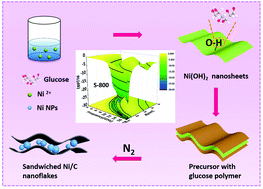Encapsulating metal nanoparticles inside carbon nanoflakes: a stable absorbent designed from free-standing sandwiched composites
Abstract
Combination of carbon and metal materials is a good strategy to develop lightweight microwave absorbents. Taking advantage of the encapsulation property of carbon nanoflakes, a stable microwave absorber could be achieved. In this study, we managed to achieve sandwich-shaped Ni/C nanoflakes via a simple route involving a one-step hydrothermal method towards Ni(OH)2 nanosheets, followed by a calcination procedure. These sandwiched carbon nanoflakes not only increased the interfacial polarization, but also resulted in the absolute stability of metal nanoparticles. Considering the higher possibility of some support plates to be wrinkled, which would bring about imperfect sandwiched structures, the free-standing sandwiched composites were in a relatively good shape. Furthermore, the intensive conductive loss could be highly responsible for better microwave absorption properties by adjusting the carbonization temperature. The minimum reflection loss (RL) value of Ni/C composites that were obtained with a 25% loading filler ratio could reach −24.3 dB with a matching thickness of only 1.5 mm. Moreover, the effective microwave absorption bandwidth (<−10 dB) could reach to 4.0 GHz with thicknesses of both 1.3 mm and 1.4 mm. Therefore, the sandwich-shaped Ni/C nanoflakes could be exploited as an effective and lightweight microwave absorber.



 Please wait while we load your content...
Please wait while we load your content...